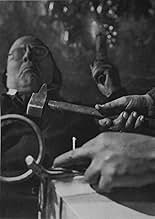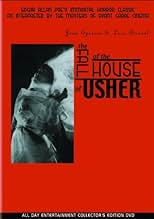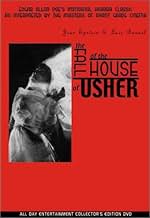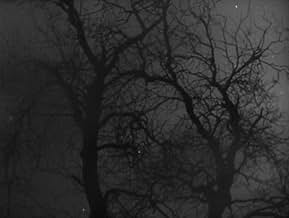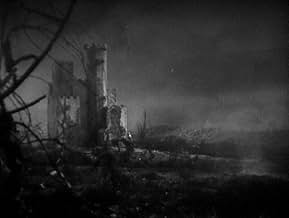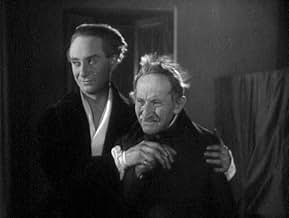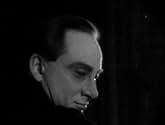IMDb रेटिंग
7.2/10
4.9 हज़ार
आपकी रेटिंग
अपनी भाषा में प्लॉट जोड़ेंAllan visits the sinister Usher family mansion, where his friend Roderick is painting a portrait of his sickly wife Madeline. The portrait seems to be draining the life out of Madeline, slow... सभी पढ़ेंAllan visits the sinister Usher family mansion, where his friend Roderick is painting a portrait of his sickly wife Madeline. The portrait seems to be draining the life out of Madeline, slowly leading to her death.Allan visits the sinister Usher family mansion, where his friend Roderick is painting a portrait of his sickly wife Madeline. The portrait seems to be draining the life out of Madeline, slowly leading to her death.
- निर्देशक
- लेखक
- स्टार
फ़ीचर्ड समीक्षाएं
The Fall of the House of Usher is about... well, I suppose it's about someone, Allan, visiting the house of Usher, run by Roderick, who lives with his sick wife Madeline and spends most of his time painting and trying to find a cure for whatever her supernatural-esquire disease is. The rest of what happens I cannot really say. Maybe because I'm still not totally sure myself. While I've yet to read the original Poe story, or see the later, more well known Roger Corman production with Vincent Price, I would probably advise on what little I know in comparing both films for the 1960 version if you're most concerned about sticking straight to the story.
Apparently, by the way, Luis Bunuel, who was director Jean Epstein's chief collaborator, quit after creative clashes over this issue. For whatever reason it was, I'd be hard-pressed to figure on how much influence he did or didn't leave on the picture. As it stands, and probably sticking to a certain aesthetic that was familiar for those in love with Poe, the silent version of Fall of the House of Usher is chock full of atmosphere in every kind of delicious, creepy, wonderful kind of connotation. The production design is sometimes full of a smoke, or a smoke-filled tint from the camera, and the outside of the mansion is covered in dirty fields and dead trees. The inside of the house, the interiors of the walls, the mirrors, the paints of Roderick's, and the placement of the camera in some strange angles (i.e. guitar) all build up to something unexpected.
Would I call it surrealism just because of Bunuel's involvement? Yes and no. Yes in that, of course, there are some striking moments that could only come out of a dream &/or a desire to just completely tool around with the audience's head just for the hell of it. And no because it's really Epstein's movie through it all, and he crafts this mostly as a somber, quietly intense picture where he experiments not in as a surrealist but as a director of contemplative Gothic horror. I can't even totally understand what absorbed me, but everything in the 'plastic', technical sense of the word did, not to mention the performances by Debucourt, Lamy, and especially Gance who all seem to be drifting in and out of the fantastical consciousness that seems to be living in this place, where life and death merge or go un-hinged, and (as another reviewer noted) is like a slow-poisoning prison.
Just, as I said, don't watch it to be wrapped up in 'what happens next in the "plot"', as it's more about what may happen in the next twist with a setting or a mood, or if a character should suddenly have a look that changes everything. It's not the greatest of the near-end silent period, but it's close.
Apparently, by the way, Luis Bunuel, who was director Jean Epstein's chief collaborator, quit after creative clashes over this issue. For whatever reason it was, I'd be hard-pressed to figure on how much influence he did or didn't leave on the picture. As it stands, and probably sticking to a certain aesthetic that was familiar for those in love with Poe, the silent version of Fall of the House of Usher is chock full of atmosphere in every kind of delicious, creepy, wonderful kind of connotation. The production design is sometimes full of a smoke, or a smoke-filled tint from the camera, and the outside of the mansion is covered in dirty fields and dead trees. The inside of the house, the interiors of the walls, the mirrors, the paints of Roderick's, and the placement of the camera in some strange angles (i.e. guitar) all build up to something unexpected.
Would I call it surrealism just because of Bunuel's involvement? Yes and no. Yes in that, of course, there are some striking moments that could only come out of a dream &/or a desire to just completely tool around with the audience's head just for the hell of it. And no because it's really Epstein's movie through it all, and he crafts this mostly as a somber, quietly intense picture where he experiments not in as a surrealist but as a director of contemplative Gothic horror. I can't even totally understand what absorbed me, but everything in the 'plastic', technical sense of the word did, not to mention the performances by Debucourt, Lamy, and especially Gance who all seem to be drifting in and out of the fantastical consciousness that seems to be living in this place, where life and death merge or go un-hinged, and (as another reviewer noted) is like a slow-poisoning prison.
Just, as I said, don't watch it to be wrapped up in 'what happens next in the "plot"', as it's more about what may happen in the next twist with a setting or a mood, or if a character should suddenly have a look that changes everything. It's not the greatest of the near-end silent period, but it's close.
A stranger called Allan (Charles Lamy) goes to an inn and requests transportation to the House of Usher. The locals remain reluctant, but he gets a coach to transport him to the place. He is the sole friend of Roderick Usher (Jean Debucourt), who leaves in the eerie house with his sick wife Madeleine Usher (Marguerite Gance) and her doctor (Fournez-Goffard). Madeleine is the beloved muse and model and is being painted by Roderick. When she dies, Roderick does not accept her death, and in a dark night, Madeleine returns.
For those like me that have not read the story of Edgar Allan Poe, the conclusion of "La Chute de la Maison Usher" is quite confused. However, the Gothic cinematography is very impressive, recalling the German Expressionism. It is amazing how Jean Epstein was able to produce such atmosphere, considering the primitive technology of 1928, with difficulties in lighting, sensibility of films, edition table and portability of cameras. However, the shadows and lights are really amazing in this black and white film. This movie was the first work of Luis Buñuel in the cinema industry, working as assistant of Jean Epstein. Just as a curiosity, the resemblance of Charles Lamy with Carlos Alberto Parreira, the coach of the Brazilian soccer team, is incredible. My vote is nine.
Title (Brazil): "A Queda da Casa de Usher" ("The Fall of the House of Usher")
For those like me that have not read the story of Edgar Allan Poe, the conclusion of "La Chute de la Maison Usher" is quite confused. However, the Gothic cinematography is very impressive, recalling the German Expressionism. It is amazing how Jean Epstein was able to produce such atmosphere, considering the primitive technology of 1928, with difficulties in lighting, sensibility of films, edition table and portability of cameras. However, the shadows and lights are really amazing in this black and white film. This movie was the first work of Luis Buñuel in the cinema industry, working as assistant of Jean Epstein. Just as a curiosity, the resemblance of Charles Lamy with Carlos Alberto Parreira, the coach of the Brazilian soccer team, is incredible. My vote is nine.
Title (Brazil): "A Queda da Casa de Usher" ("The Fall of the House of Usher")
Wow! Words cannot describe how absolutely magical this film is, but I will try. Its not often that a film will truly captivate me from moment one as this one has, especially in the world of silent film. Its been a long time since I've been glued to the screen in complete rapture. Granted, I like the silent medium and of course I respect it, but usually I watch them as a piece of film history; I see them for what they are and judge them only amongst their peers: other silent films. But this silent film is like no other! There were many times when I felt as though if Guy Maddin were to make a actual serious film this would be it. Anyone who has seen 'Cowards Bend The Knee' or 'Saddest Music In The World' will know what I'm referring to. Throughout the film I kept thinking that it looked "new" and was made to look old. Some of the special effects such as the swirling fog were just mesmerizing so much so that I found myself wondering why in our modern day we haven't done something so simple yet effective (at least as compared to the films I've experienced).
Even the score that they created for it was incredible. There were some scenes in the beginning of the film, especially ones where Allan was approaching the house, that I didn't think quite fit, but for the rest of the 95% of the film it went along with the action of the film perfectly.
While everything in the film is as close to perfect as film gets, I must point out the acting was so well done as to almost bring me to tears. I cant quite explain how that is possible, but it is. Each tiny emotion shows through so remarkably well. I really would love to commend the actor who played Roderick Usher for his wonderful display. I even feel right in comparing his acting to the likes of the female lead in 'The Passion Of Joan Of Arc' -- and thats hard to beat!
Oh, and the cinematography! Its absolutely impeccable! And I'm not just saying that due to the fact that "its the best they could do back then". It really could rival any modern day film in that regard. It makes me miss shots of a large looming building from down below instead of the aerial helicopter shots most films use now; so macabre and eerily inviting. This film was definitely ahead of its time thats for sure.
I'm not sure how much a screenplay translates to a silent film, but whatever/however Bunuel contributed, it definitely worked. Even though there weren't any overtly surrealistic things going on, you could definitely smell the Bunuel in it. The film is like a dream that you don't want to wake up from even though at its heart it is a nightmare.
Even the score that they created for it was incredible. There were some scenes in the beginning of the film, especially ones where Allan was approaching the house, that I didn't think quite fit, but for the rest of the 95% of the film it went along with the action of the film perfectly.
While everything in the film is as close to perfect as film gets, I must point out the acting was so well done as to almost bring me to tears. I cant quite explain how that is possible, but it is. Each tiny emotion shows through so remarkably well. I really would love to commend the actor who played Roderick Usher for his wonderful display. I even feel right in comparing his acting to the likes of the female lead in 'The Passion Of Joan Of Arc' -- and thats hard to beat!
Oh, and the cinematography! Its absolutely impeccable! And I'm not just saying that due to the fact that "its the best they could do back then". It really could rival any modern day film in that regard. It makes me miss shots of a large looming building from down below instead of the aerial helicopter shots most films use now; so macabre and eerily inviting. This film was definitely ahead of its time thats for sure.
I'm not sure how much a screenplay translates to a silent film, but whatever/however Bunuel contributed, it definitely worked. Even though there weren't any overtly surrealistic things going on, you could definitely smell the Bunuel in it. The film is like a dream that you don't want to wake up from even though at its heart it is a nightmare.
As was inevitable, movies of the silent era depended on their imagery in a way that became less important after the introduction of sound. During the same time period there were a number of hugely significant art movements that would influence the relatively new medium of cinema. Art trends such as cubism, dada, expressionism and surrealism had enormous impact on films of the time. The Fall of the House of Usher is a good example of a film based on 19th century literature but brought to the screen via the artistic sensibilities of the day, namely expressionism and surrealism. Because of this, like its peers such as The Cabinet of Dr. Caligari and Nosferatu, it has attained a timeless quality and it will always remain a fascinating art-horror film.
The plot-line such that it is, is about a man named Allan who visits his friend Roderick Usher at his remote mansion. Usher lives with his sick wife Madeline, who suffers from some mysterious unknown disease. He is obsessed in painting a portrait of her. She dies and Usher, unable to accept it, descends into madness.
The tone is definitely downbeat and this is reflected by the gloomy haunting imagery used throughout. The strikingly inventive visuals escalate as the film progresses as a way of reflecting Roderick Usher's journey into insanity. Billowing curtains, close-ups of a giant pendulum, a haunting painting of Usher's wife, a moon-lit trip to the mausoleum and swirling mist are just some of the details captured. The film is overloaded in creepy Gothic atmosphere. Production design is excellent, with the grounds of the mansion populated with dead trees and swirling mist, while the interior has enormously high ceilinged rooms decorated with mirrors, curtains and Gothic furniture. In keeping with the film's artistic bent, everything is photographed quite excellently with many close-ups and unusual angles. The overall feeling of the film is that of a fever-dream which is very much in keeping with the central character's damaged state of mind.
In the best silent films, the storyline is very much secondary to the ambiance. The Fall of the House of Usher is no different and is one of the greatest silent horror films. It's an often quite stunning mood piece and comes highly recommended.
The plot-line such that it is, is about a man named Allan who visits his friend Roderick Usher at his remote mansion. Usher lives with his sick wife Madeline, who suffers from some mysterious unknown disease. He is obsessed in painting a portrait of her. She dies and Usher, unable to accept it, descends into madness.
The tone is definitely downbeat and this is reflected by the gloomy haunting imagery used throughout. The strikingly inventive visuals escalate as the film progresses as a way of reflecting Roderick Usher's journey into insanity. Billowing curtains, close-ups of a giant pendulum, a haunting painting of Usher's wife, a moon-lit trip to the mausoleum and swirling mist are just some of the details captured. The film is overloaded in creepy Gothic atmosphere. Production design is excellent, with the grounds of the mansion populated with dead trees and swirling mist, while the interior has enormously high ceilinged rooms decorated with mirrors, curtains and Gothic furniture. In keeping with the film's artistic bent, everything is photographed quite excellently with many close-ups and unusual angles. The overall feeling of the film is that of a fever-dream which is very much in keeping with the central character's damaged state of mind.
In the best silent films, the storyline is very much secondary to the ambiance. The Fall of the House of Usher is no different and is one of the greatest silent horror films. It's an often quite stunning mood piece and comes highly recommended.
Predictably morbid and grim, this early cinematic tribute to Poe offers some interesting images and beautifully haunting music. I liked the sequence showing the lace-draped coffin, as it was carried out of that cavernous room.
More stylistic than substantive, the overall effect of the film is to engender a sense of suffocating gloom, rather than to tell an interesting story. It's very much like what one would expect in a nightmare. Space seems strung-out. People are not quite real. Pacing is so slow as to render time suspended between two swings of the clock pendulum.
I don't recall a film that conveyed such an overwhelming sense of introverted bleakness, oppression, and ubiquitous death. Even the trees were dead.
A lot of viewers will find this film lifeless ... so to speak. But for those interested in the antiquity of the occult, or Poe in particular, this film will excite like no other.
More stylistic than substantive, the overall effect of the film is to engender a sense of suffocating gloom, rather than to tell an interesting story. It's very much like what one would expect in a nightmare. Space seems strung-out. People are not quite real. Pacing is so slow as to render time suspended between two swings of the clock pendulum.
I don't recall a film that conveyed such an overwhelming sense of introverted bleakness, oppression, and ubiquitous death. Even the trees were dead.
A lot of viewers will find this film lifeless ... so to speak. But for those interested in the antiquity of the occult, or Poe in particular, this film will excite like no other.
क्या आपको पता है
- ट्रिवियाLuis Buñuel, who was Assistant Director, quit the picture after clashing with producer/director Jean Epstein over Epstein's decision to basically ignore Edgar Allan Poe's story.
- कनेक्शनEdited into Histoire(s) du cinéma: Une vague nouvelle (1999)
टॉप पसंद
रेटिंग देने के लिए साइन-इन करें और वैयक्तिकृत सुझावों के लिए वॉचलिस्ट करें
- How long is The Fall of the House of Usher?Alexa द्वारा संचालित
विवरण
- रिलीज़ की तारीख़
- कंट्री ऑफ़ ओरिजिन
- भाषा
- इस रूप में भी जाना जाता है
- The Fall of the House of Usher
- फ़िल्माने की जगहें
- उत्पादन कंपनी
- IMDbPro पर और कंपनी क्रेडिट देखें
- चलने की अवधि1 घंटा 12 मिनट
- रंग
- ध्वनि मिश्रण
- पक्ष अनुपात
- 1.33 : 1
इस पेज में योगदान दें
किसी बदलाव का सुझाव दें या अनुपलब्ध कॉन्टेंट जोड़ें


